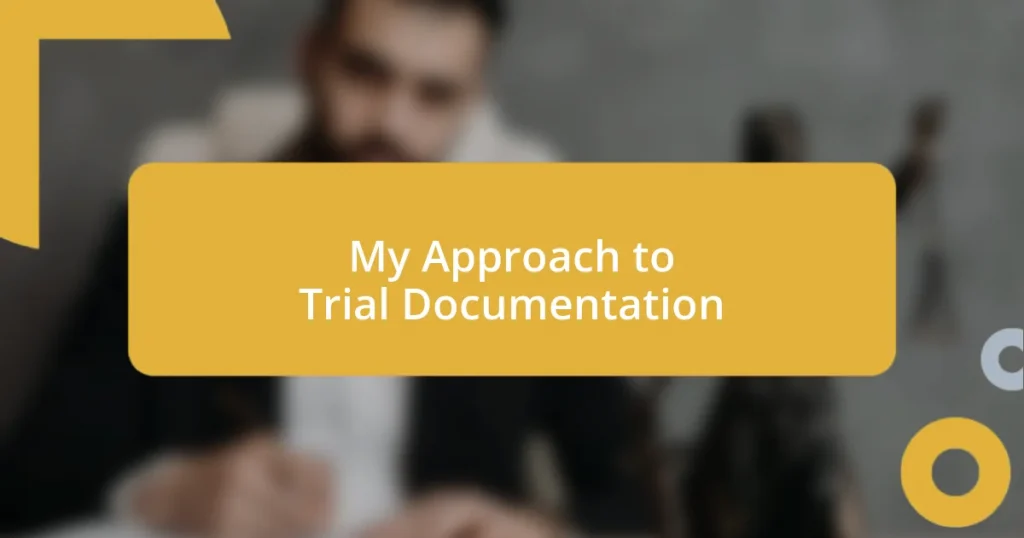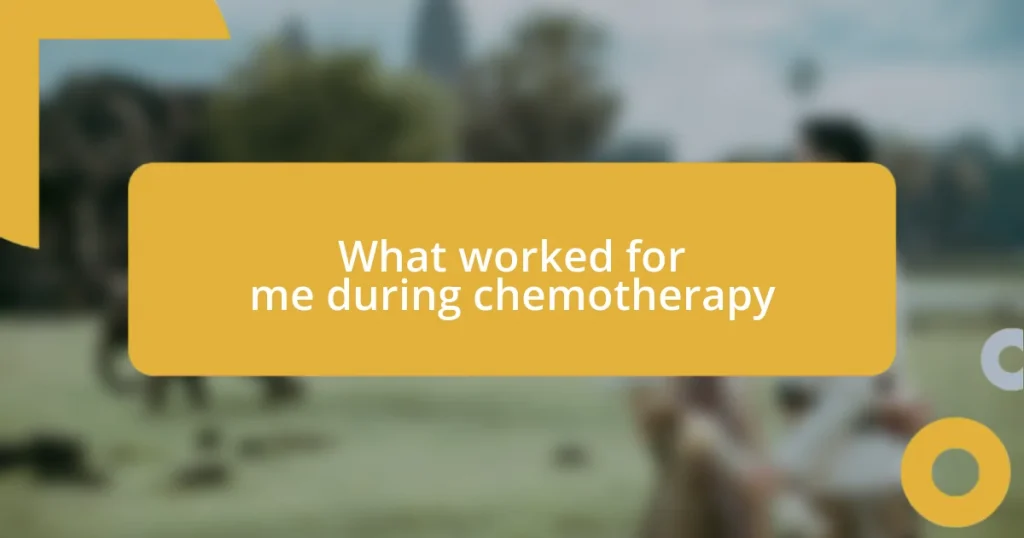Key takeaways:
- Effective trial documentation starts early with meticulous note-taking and organization, significantly impacting trial success.
- Key components of trial documents include a comprehensive case summary, exhibit list, and witness list, which are crucial for a cohesive narrative.
- Common mistakes to avoid include not updating documents, neglecting proofreading, and being overly vague, as these can undermine credibility and clarity.

Understanding Trial Documentation Process
Understanding the trial documentation process can often feel overwhelming. I recall my early days in the courtroom when I was frazzled by the sheer volume of paperwork required. It made me wonder: how do seasoned professionals manage to keep everything organized and streamlined?
It’s essential to recognize that effective trial documentation begins long before the trial itself. From my experience, I’ve found that meticulous note-taking during the discovery phase can save countless hours later on. Have you ever found yourself retracing your steps to piece together facts? I know I have, and it’s a daunting task when you’re neck-deep in litigation.
Additionally, the way documentation is organized can greatly impact trial success. I remember a case where my team utilized color-coded binders. It seemed trivial at first, but having everything visually distinct made it easier to find crucial documents under pressure. Isn’t it fascinating how small changes in approach can lead to significant improvements in efficiency?

Importance of Detailed Documentation
Detailed documentation is a linchpin in the trial process. I remember a particular case where I meticulously documented every witness statement and piece of evidence. During the trial, when the opposing counsel challenged our narrative, those well-organized notes allowed me to respond confidently and accurately. It’s amazing how thorough documentation can turn potential pitfalls into opportunities for clarity.
Here are a few key benefits of detailed documentation:
- Consistency: Detailed records support a cohesive narrative throughout the trial.
- Credibility: Well-documented evidence strengthens our position, showing diligence and preparedness.
- Efficiency: Having everything organized saves time during critical moments, allowing for quick retrieval of information.
- Compliance: Comprehensive documentation helps adhere to legal standards and protocols, reducing risks of disputes.
- Preparation for Appeals: Detailed notes provide a solid foundation if the case is challenged later, serving as a clear reference point for what transpired.
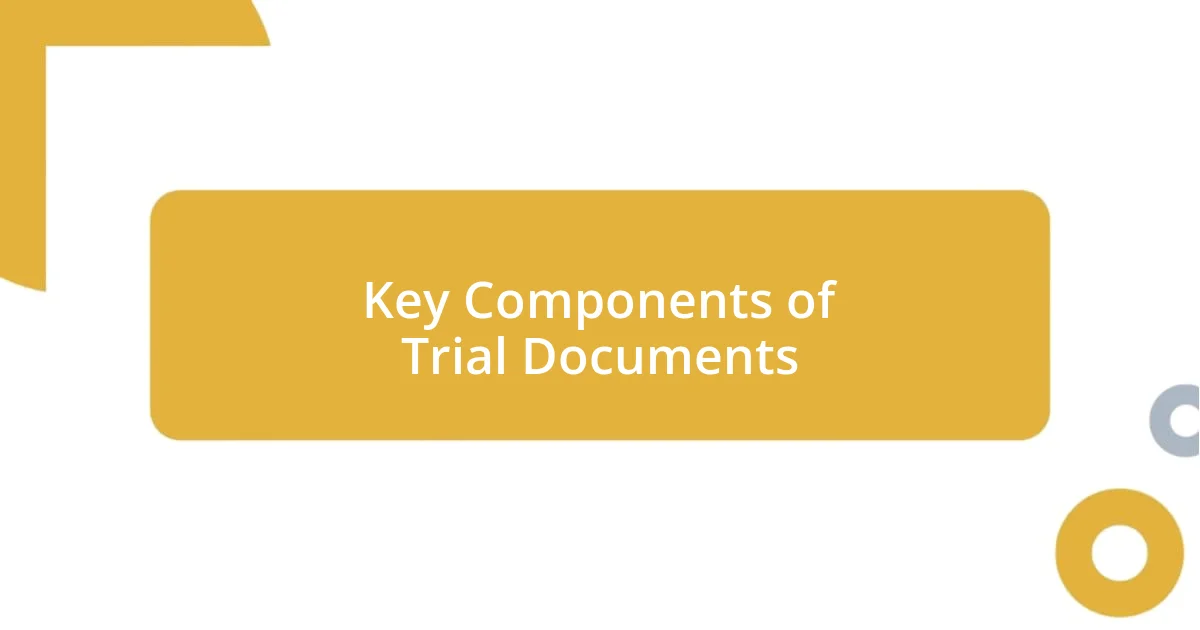
Key Components of Trial Documents
When I reflect on trial documents, several key components come to mind. First, we must consider the case summary. This single document encapsulates the essence of the case, its critical points, and the legal framework. I still remember the sense of clarity I felt when creating a concise summary that served as both a roadmap and a quick reference throughout the trial. It’s like having a compass in uncharted territory; without it, you risk losing your way.
Another essential element is the exhibit list, which acts as a catalog of all the evidence to be presented. While assembling this list can be tedious, I find it’s absolutely vital. I had a moment once where I stumbled upon a vital piece of evidence I had almost forgotten. Having it meticulously indexed allowed me to bring it to the forefront at just the right moment, shifting the case in our favor. These experiences have reinforced my belief that each document plays a significant role in weaving a coherent and convincing narrative.
Lastly, the witness list is crucial as it details who will testify and the themes of their testimonies. I recall drafting this list with anticipation and a pinch of anxiety, contemplating how each witness would contribute to our story. It dawned on me how every individual could shift the dynamics of our case—each one a key player. When I see this list, I sense an intricate web of relationships forming that can either strengthen or weaken our case.
| Component | Description |
|---|---|
| Case Summary | A comprehensive overview that outlines the key aspects of the case, providing a roadmap for the trial. |
| Exhibit List | A detailed catalog of all evidence, ensuring that important documents are readily accessible during proceedings. |
| Witness List | A compilation of individuals set to testify, highlighting their contributions to the case narrative. |

Best Practices for Creating Documents
Creating effective trial documents isn’t just about putting words on a page; it’s about crafting a narrative that resonates. One practice that has served me well is to start each document with clarity in mind. How can I ensure that every reader understands the essence of what I’m conveying? I recommend breaking down complex concepts into simple, straightforward language. For example, when I was summarizing a particularly intricate case, I focused on the critical points and eliminated jargon. It was a game-changer—not only for my understanding but also for anyone who might refer to the document later.
In my experience, using a consistent format for all documents plays a vital role in enhancing clarity. I recall a daunting trial where I decided to adopt a uniform structure for my notes, witness statements, and evidence lists. This decision transformed how information flowed; everything became instinctively accessible. Have you ever found yourself searching in vain for a piece of evidence during a tense moment? I have, and let me tell you, the frustration can be overwhelming. That’s why I prioritize consistency — it’s like using a map where every landmark is clearly marked.
It’s essential to infuse emotion and urgency into your documentation as well. When drafting a witness statement, it’s not merely about the facts; it’s about capturing the weight of their words. I remember listening to a witness recount their experience, and I felt a profound responsibility to represent their voice authentically. By including impactful quotes or anecdotes, I turned sterile outlines into compelling narratives that not only informed but also engaged. Wouldn’t you agree that a powerful story can leave a lasting impact, especially in the high-stakes context of a trial?

Common Mistakes to Avoid
One of the most frequent mistakes I see is the failure to maintain updated versions of documents throughout the trial. There was a time when I relied on an older draft of a witness statement, thinking it was still accurate. When the witness provided new details during their testimony, I could feel the panic rising. Keeping a meticulous track of updates is crucial; otherwise, you risk providing inaccurate information, which can undermine your credibility in the courtroom.
Another common pitfall is neglecting the importance of proofreading. It sounds simple, but I can’t stress enough how overlooking typos or grammatical errors can create a perception of carelessness. I recall submitting a key document that had a few glaring mistakes, not realizing how they might detract from the serious nature of our case. It was a harsh reminder that attention to detail matters.
Finally, a significant mistake is being overly vague in your documentation. I remember drafting a case summary that was so broad it lacked the necessary focus, which left my team unsure about our strategy. It dawned on me that every detail counts. Specificity not only clarifies your points but also strengthens your arguments—think of it as adding rich colors to a painting rather than shading everything in gray. How could I expect others to be just as invested in our narrative if I couldn’t commit to expressing it clearly?
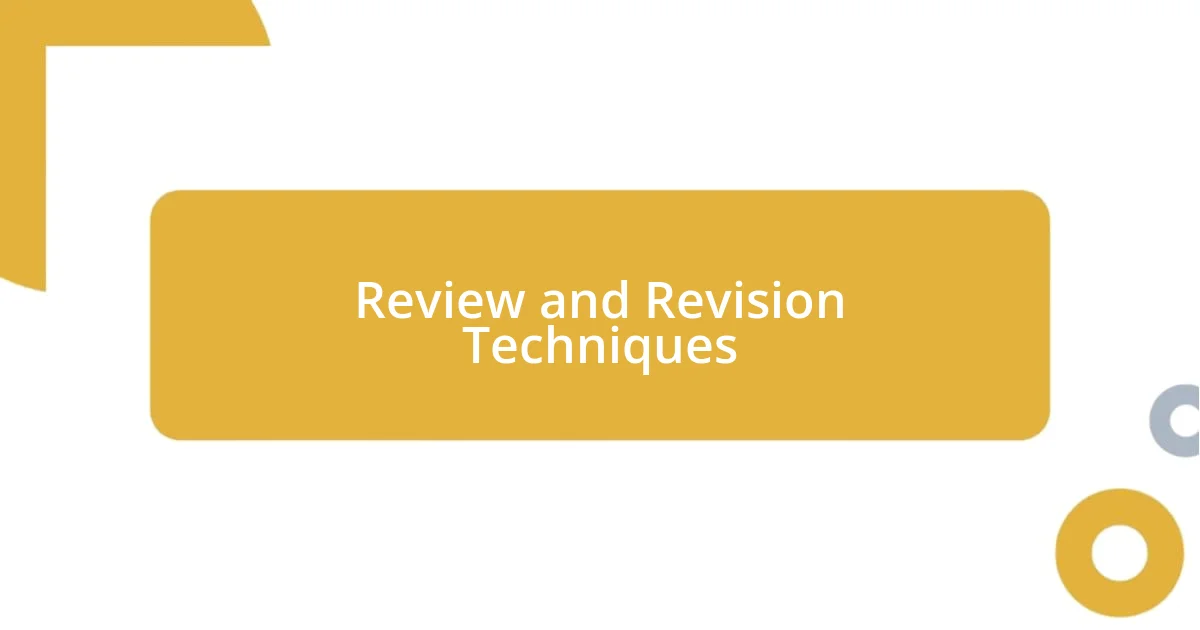
Review and Revision Techniques
Reviewing and revising trial documentation is a process that directly impacts the quality of the final product. I often set aside my drafts for a day or two before revisiting them. This brief break allows me to approach the material with fresh eyes, making it easier to spot inconsistencies or areas that require clarification. Have you ever noticed how small errors become glaringly obvious after a short hiatus?
In my practice, I find that collaborating with a colleague during the revision process is incredibly beneficial. We often exchange documents and provide feedback, which adds a layer of scrutiny I might overlook. I recall a specific instance when a colleague caught a misinterpretation of a witness statement that could have affected our strategy. That moment reinforced my belief that two sets of eyes are always better than one.
Another technique I value is creating checklists for different document types. Whether it’s a trial brief or an exhibit list, having a tailored checklist helps ensure that I don’t miss any critical components. It might seem tedious, but it’s like having a safety net that enhances my confidence. I still remember the relief I felt when my checklist saved me from omitting essential case law in a pivotal brief. What methods do you use to ensure your documents maintain their integrity throughout the trial process?
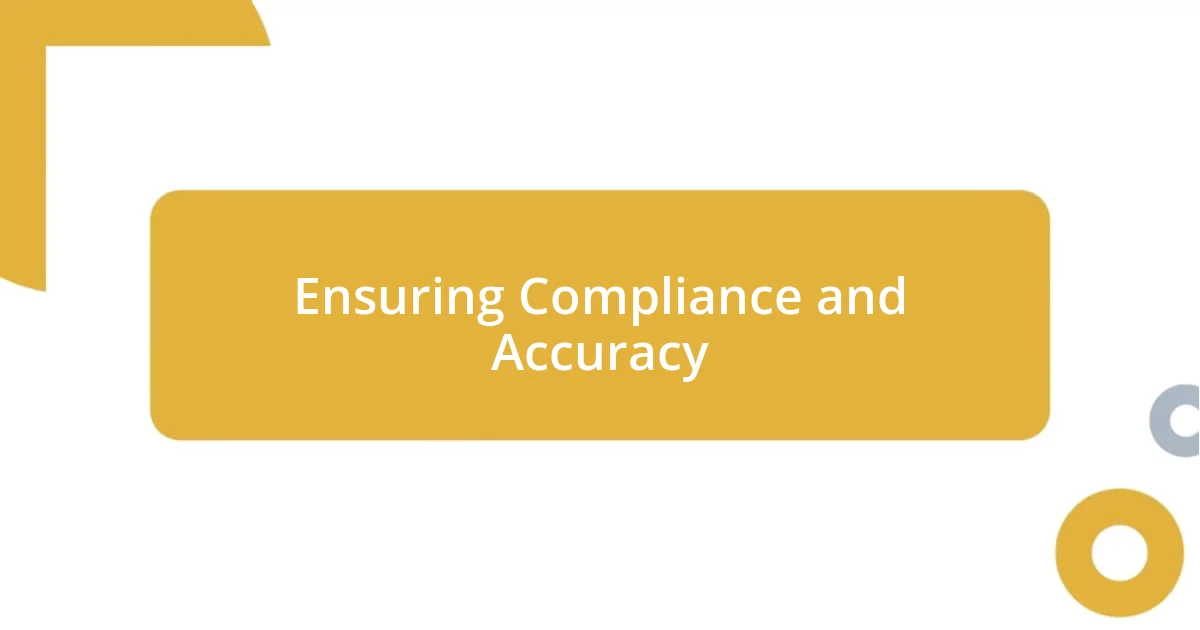
Ensuring Compliance and Accuracy
Ensuring compliance and accuracy in trial documentation is non-negotiable. I’ve learned that even the smallest deviation can lead to significant consequences. Once, I encountered a case where a simple date discrepancy in our filings resulted in misunderstandings that jeopardized our timeline. This experience taught me that consistent attention to detail is essential; it’s the bedrock on which our credibility stands.
I’ve found that using standardized templates for various documents not only streamlines the process but also bolsters accuracy. One project I worked on had multiple moving parts, and we used templates for witness statements and court filings. Looking back, I realize that these templates served as a crucial framework that eliminated common errors. It’s like having a strong foundation for a house; if the base is solid, the rest will stand securely.
Another method I swear by involves keeping a compliance checklist that outlines legal requirements and deadlines. I recall a frantic last-minute review before a hearing, where I discovered that I hadn’t verified a crucial compliance point. The adrenaline was pumping, but that checklist saved me time and ensured everything met the necessary standards. Have you ever experienced that rush of relief when a simple tool helps avert a potential crisis? It’s moments like these that highlight how vital meticulousness is in our field.










